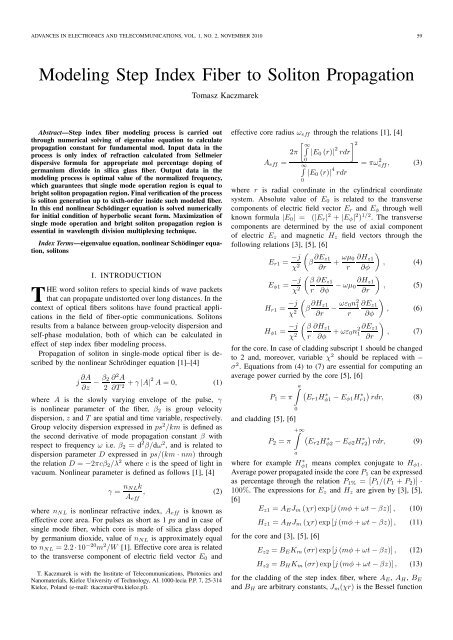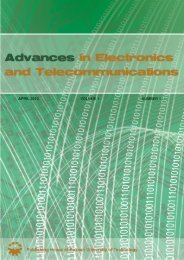november 2010 volume 1 number 2 - Advances in Electronics and ...
november 2010 volume 1 number 2 - Advances in Electronics and ...
november 2010 volume 1 number 2 - Advances in Electronics and ...
You also want an ePaper? Increase the reach of your titles
YUMPU automatically turns print PDFs into web optimized ePapers that Google loves.
ADVANCES IN ELECTRONICS AND TELECOMMUNICATIONS, VOL. 1, NO. 2, NOVEMBER <strong>2010</strong> 59<br />
Model<strong>in</strong>g Step Index Fiber to Soliton Propagation<br />
Abstract—Step <strong>in</strong>dex fiber model<strong>in</strong>g process is carried out<br />
through numerical solv<strong>in</strong>g of eigenvalue equation to calculate<br />
propagation constant for fundamental mod. Input data <strong>in</strong> the<br />
process is only <strong>in</strong>dex of refraction calculated from Sellmeier<br />
dispersive formula for appropriate mol percentage dop<strong>in</strong>g of<br />
germanium dioxide <strong>in</strong> silica glass fiber. Output data <strong>in</strong> the<br />
model<strong>in</strong>g process is optimal value of the normalized frequency,<br />
which guarantees that s<strong>in</strong>gle mode operation region is equal to<br />
brightsolitonpropagation region.F<strong>in</strong>alverificationof theprocess<br />
is soliton generation up to sixth-order <strong>in</strong>side such modeled fiber.<br />
In this end nonl<strong>in</strong>ear Schöd<strong>in</strong>ger equation is solved numerically<br />
for <strong>in</strong>itial condition of hyperbolic secant form. Maximization of<br />
s<strong>in</strong>gle mode operation <strong>and</strong> bright soliton propagation region is<br />
essential <strong>in</strong> wavelength division multiplex<strong>in</strong>g technique.<br />
IndexTerms—eigenvalue equation,nonl<strong>in</strong>earSchöd<strong>in</strong>gerequation,<br />
solitons<br />
Tomasz Kaczmarek<br />
I. INTRODUCTION<br />
THE word soliton refers to special k<strong>in</strong>ds of wave packets<br />
that can propagate undistorted over long distances. In the<br />
context of optical fibers solitons have found practical applications<br />
<strong>in</strong> the field of fiber-optic communications. Solitons<br />
results from a balance between group-velocity dispersion <strong>and</strong><br />
self-phase modulation, both of which can be calculated <strong>in</strong><br />
effect of step <strong>in</strong>dex fiber model<strong>in</strong>g process.<br />
Propagation of soliton <strong>in</strong> s<strong>in</strong>gle-mode optical fiber is described<br />
by the nonl<strong>in</strong>ear Schröd<strong>in</strong>ger equation [1]–[4]<br />
j ∂A<br />
∂z<br />
− β2<br />
2<br />
∂ 2 A<br />
∂T 2 + γ |A|2 A = 0, (1)<br />
where A is the slowly vary<strong>in</strong>g envelope of the pulse, γ<br />
is nonl<strong>in</strong>ear parameter of the fiber, β2 is group velocity<br />
dispersion, z <strong>and</strong> T are spatial <strong>and</strong> time variable, respectively.<br />
Group velocity dispersion expressed <strong>in</strong> ps 2 /km is def<strong>in</strong>ed as<br />
the second derivative of mode propagation constant β with<br />
respect to frequency ω i.e. β2 = d 2 β/dω 2 , <strong>and</strong> is related to<br />
dispersion parameter D expressed <strong>in</strong> ps/(km · nm) through<br />
the relation D = −2πcβ2/λ 2 where c is the speed of light <strong>in</strong><br />
vacuum. Nonl<strong>in</strong>ear parameter is def<strong>in</strong>ed as follows [1], [4]<br />
γ = nNLk<br />
, (2)<br />
Aeff<br />
where nNL is nonl<strong>in</strong>ear refractive <strong>in</strong>dex, Aeff is known as<br />
effective core area. For pulses as short as 1 ps <strong>and</strong> <strong>in</strong> case of<br />
s<strong>in</strong>gle mode fiber, which core is made of silica glass doped<br />
by germanium dioxide, value of nNL is approximately equal<br />
to nNL = 2.2 · 10 −20 m 2 /W [1]. Effective core area is related<br />
to the transverse component of electric field vector E0 <strong>and</strong><br />
T. Kaczmarek is with the Institute of Telecommunications, Photonics <strong>and</strong><br />
Nanomaterials, Kielce University of Technology, Al. 1000-lecia P.P.7, 25-314<br />
Kielce, Pol<strong>and</strong> (e-mail: tkaczmar@tu.kielce.pl).<br />
effective core radius ωeff through the relations [1], [4]<br />
� ∞�<br />
2π |E0 (r)|<br />
0<br />
Aeff =<br />
2 �2 rdr<br />
∞�<br />
|E0 (r)| 4 = πω<br />
rdr<br />
2 eff , (3)<br />
0<br />
where r is radial coord<strong>in</strong>ate <strong>in</strong> the cyl<strong>in</strong>drical coord<strong>in</strong>ate<br />
system. Absolute value of E0 is related to the transverse<br />
components of electric field vector Er <strong>and</strong> Eφ through well<br />
known formula |E0| = (|Er| 2 + |Eφ| 2 ) 1/2 . The transverse<br />
components are determ<strong>in</strong>ed by the use of axial component<br />
of electric Ez <strong>and</strong> magnetic Hz field vectors through the<br />
follow<strong>in</strong>g relations [3], [5], [6]<br />
Er1 = −j<br />
χ 2<br />
Hr1 = −j<br />
χ 2<br />
�<br />
β ∂Ez1<br />
∂r<br />
Eφ1 = −j<br />
χ2 �<br />
β<br />
r<br />
�<br />
β ∂Hz1<br />
Hφ1 = −j<br />
χ 2<br />
∂Ez1<br />
∂φ<br />
+ ωµ0<br />
r<br />
− ωµ0<br />
∂r − ωε0n2 1<br />
r<br />
�<br />
β ∂Hz1<br />
r ∂φ + ωε0n 2 1<br />
�<br />
∂Hz1<br />
, (4)<br />
∂φ<br />
∂Hz1<br />
∂r<br />
∂Ez1<br />
∂φ<br />
∂Ez1<br />
∂r<br />
�<br />
, (5)<br />
�<br />
, (6)<br />
�<br />
, (7)<br />
for the core. In case of cladd<strong>in</strong>gsubscript 1 should be changed<br />
to 2 <strong>and</strong>, moreover, variable χ 2 should be replaced with –<br />
σ 2 . Equations from (4) to (7) are essential for comput<strong>in</strong>g an<br />
average power curried by the core [5], [6]<br />
�<br />
P1 = π<br />
<strong>and</strong> cladd<strong>in</strong>g [5], [6]<br />
0<br />
a<br />
�<br />
P2 = π<br />
�<br />
Er1H ∗ φ1 − Eφ1H ∗ �<br />
r1 rdr, (8)<br />
+∞<br />
�<br />
Er2H ∗ φ2 − Eφ2H ∗ r2<br />
a<br />
� rdr, (9)<br />
where for example H∗ φ1 means complex conjugate to Hφ1.<br />
Averagepowerpropagated<strong>in</strong>sidethe core P1 canbe expressed<br />
as percentage through the relation P1% = [P1/(P1 + P2)] ·<br />
100%. The expressions for Ez <strong>and</strong> Hz are given by [3], [5],<br />
[6]<br />
Ez1 = AEJm (χr) exp [j (mφ + ωt − βz)] , (10)<br />
Hz1 = AHJm (χr) exp [j (mφ + ωt − βz)] , (11)<br />
for the core <strong>and</strong> [3], [5], [6]<br />
Ez2 = BEKm (σr) exp [j (mφ + ωt − βz)] , (12)<br />
Hz2 = BHKm (σr) exp [j (mφ + ωt − βz)] , (13)<br />
for the cladd<strong>in</strong>g of the step <strong>in</strong>dex fiber, where AE, AH, BE<br />
<strong>and</strong> BH are arbitrary constants, Jm(χr) is the Bessel function







